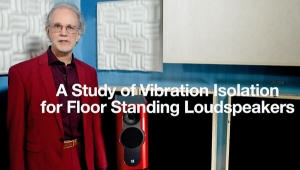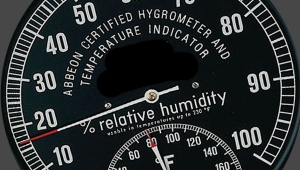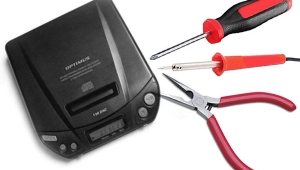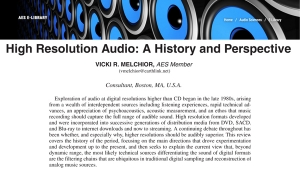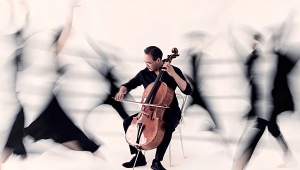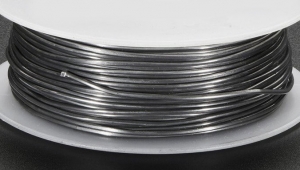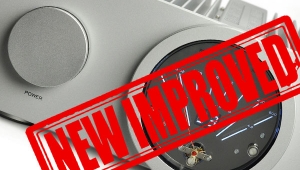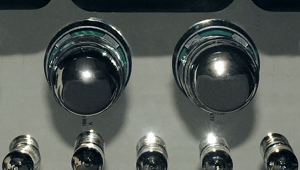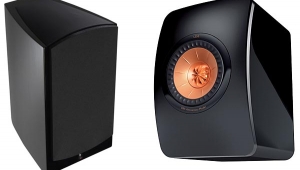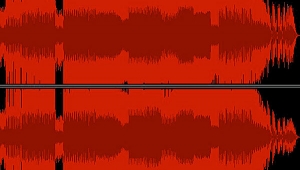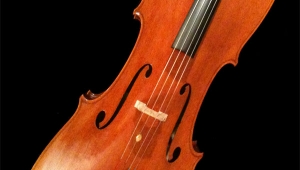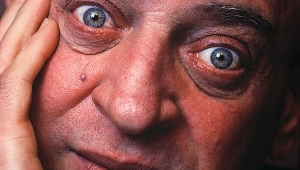| Columns Retired Columns & Blogs |
Listening Sessions and Hyperlinks Page 2
The high priests of this back-to-basics movement are the members of the band Stereolab. When I went back to my new-LP bin, their recent album Emperor Tomato Ketchup (Elektra 61840-1, LP) was staring right at me. With a title so similar to Atom Heart Mother, it seemed to be saying "play me next." So I did. Stereolab also has aspirations to high art. I first learned about them from an exhibit of theirs at the Walker Art Gallery in Minneapolis. You were instructed to sit on a bench before a large, goopy-looking slab of bright green plastic wired up with several pairs of headphones. You were then instructed to listen to the music playing through the 'phones (Stereolab, of course) and simultaneously feel the goopy-looking thing. I passed on feeling the thing, but I listened for quite a while.
Stereolab has something for everyone. There's one part Abba (for a smooth '70s Euro-pop feel), one part early Talking Heads (peppy, scratchy guitars), and a healthy dose of analog synthesizers (early Eno, Cluster, or Kraftwerk). The rest is all their own.
After Emperor Tomato Ketchup I went hunting for other examples of the pop-exotica I used to love. Before I knew better, I believed that the more obscure a recording was, the better it had to be. Obviously, a lot of my old LPs are just dead weight. (Having moved recently, I emphasize the "weight.") But when I spied The Durutti Column hiding between The Db's and (dare I admit) Echo and the Bunnymen, I knew I'd found the right segue from Stereolab.
The Durutti Column is a one-man show featuring guitarist/keyboardist/songwriter Vini Reilly. While I cleaned up his Deux Triangles EP (Factory Benelux FBN 10), it occurred to me that the last time I'd played this record was on my old Empire Troubadour. Rescuing that turntable from the dirt (literally) of a barn sale was my first official step toward high-end insanity. (Step two was stuffing the platter with Mortite.) When I cued up Triangles on my VPI 'table, however, I realized how many steps ago that was. My jaw dropped. Get thee to a used-record store! Pressed in Belgium, this EP sounds like Belgian chocolate tastes—big, smooth, and rich.
Reilly's compositions sound semi-improvised. He'll use his percussive piano playing to build up huge, reverberant spaces, then overdub electric guitars. He even uses old analog drum machines sometimes, the kind that mimic (very bad-sounding) drums and cymbals with gated pink noise. Somehow he makes them sound great. Since his piano compositions are reminiscent of Gershwin and his guitar playing sounds like Jerry Garcia's, the result is an odd but compelling mix. Playing live, The Durutti Column is just as unusual. When I saw them years ago in Chicago, Reilly juggled his keyboards and guitars while accompanied by a percussionist in a tuxedo who looked as though he'd gotten lost on his way to Symphony Hall.
Speaking of Symphony Hall, while I was enjoying "Music for an Out-of-Tune Piano," Reilly's rhythms and melodies brought an entirely different piece of music to mind. This time it was Michael Tippett's Concerto for Double String Orchestra. The recording, in which Tippett conducts the Scottish Chamber Orchestra (Virgin VC 90701), was my last choice for this session, and a suitable finale for my second hi-fi honeymoon. I especially like the furious, confusing polyrhythms in the first and third movements. There are moments when it seems even Tippett himself is not quite sure how the different lines and rhythms are supposed to weave together. This is one of my test records—if a new component can help me figure out more of what's going on, it's a keeper.
As I sat down to write about my musical afternoon, however, I couldn't convince myself that I'd really gotten away from the world of computing. Yes, my computer, mouse, and monitor were out of sight and out of mind. But I had the feeling that an old-fashioned listening session and a newfangled surf on the Internet have something in common: In each case, the media in question are structured as hypertext.
Strictly speaking, hypertext is what you browse (or surf) on the Internet. (For those who have yet to bite the Internet apple, many help screens in personal computer programs are also hypertext.) If ordinary text consists in documents to be read sequentially, like the pages of a book, hypertext consists in documents connected or linked in different, complex ways. By clicking your mouse on a link, you could, for example, jump from page 2 to page 5 in an ordinary text, or jump to page 3 in another document entirely. The World Wide Web is the result of zillions of documents variously connected (or spun) together by hypertext links of this sort.
In its own way, my listening session was a tour through documents—musical documents—linked together as hypertext. That brass passage in the Saint-Saëns, for instance, seemed to read "click here for something similar by Pink Floyd." Atom Heart Mother, in turn, was linked to Emperor Tomato Ketchup for reasons having to do with synthesizers and odd three-word titles. In each case, memory and imagination built links between recordings in my collection. In each case, I followed them.
Maybe this is the real excuse for my audiophile failings (temporary, only temporary!). I didn't realize the extent that computing was stealing time from my listening because the two activities are so similar—they have a common form, but different content. A good listening session, in other words, is a hypertextual surf through a record collection.
Skeptical? Exhibit 1: When you're surfing the Internet or listening to records, you follow a nonrandom, determinate course through documents. If I had one of those jukeboxes that holds an entire CD collection, for example, I doubt I would ever press the random play button unless I wanted only some background music; the resulting sequence of recordings would be a mishmash. That is, the links holding that listening session "together" would be artificial and uninteresting. If the seventh selection were Sarah Vaughn and the eighth were Vaughan Williams, I'd be disappointed. I like them both, no doubt, but—like pizza and pancakes—not at one sitting. Surfing the Net randomly would be a similar kind of experience. If you had no idea where links were going to take you, you'd certainly see lots of different things. But you'd be a mere spectator, and often bored.
Exhibit 2: When surfing the Net or listening to recordings, it's best not to plan every step in advance. Despite Mr. Gates's advertisement, half the fun of the Internet is not knowing where you want to go today. If you start out in the audio pages, for instance, you might find your way to car audio, sidestep into the world of antique cars, and end up finding an online tribute to Raymond Loewy and the Studebaker Avanti (one of my favorites). The fun is planning your trip while you're taking it.
It's the same with a good listening session. The logic and feelings that hold it together accumulate as you listen. If someone did choose to play Vaughan Williams right after Sarah Vaughn, that choice could make perfect sense, given the mood he or she felt three recordings before. If so, that listening session probably couldn't have been planned before the discs started spinning.
If I'm right about this, the relationship between audio and computing is not so simple. Usually, I tend to think that computers are stalking our beloved hobby. Home audio may have survived the rise of home video (at least at my place), but it's only a matter of time before both home video and home audio are swallowed up by powerful multimedia computing systems. Amplifiers, disc changers, and VCRs will remain tucked out of sight while you control all your applications—audio, video, telephone, Internet, climate control, etc.—with a mouse and monitor. Instead of having to rummage through piles of LPs, CDs, or tapes, we may just scroll through lists of recordings and call them up from a hard drive or download them from the Internet. (I know, this is starting to sound like Zager & Evans's "In the Year 2525.") Even loudspeakers may become obsolete—we'll just connect our systems directly to the auditory centers of our brains. Hopefully, our love for big, heavy cables and megawatt amplifiers will be over by then.
What won't change is the hypertextual structure of a good listening session. The World Wide Web is just a much bigger version of the kind of textual space audiophiles have been enjoying all along. In the beginning was the Shelf-Wide Web. Each of us can find meaningful hypertext paths reaching from our Alwyn to our Zappa, and that's exactly what happy listening and happy record collecting are all about. Computing and the Internet craze are just catching on.
- Log in or register to post comments
